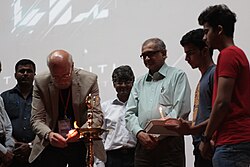Blog Credit: Trupti Thakur
Image Courtesy: Google
First 1000 Days In Space
Oleg Kononenko, a 59-year-old Russian cosmonaut, recently achieved a historic landmark by becoming the first person to spend 1,000 days in space. Announced by Roscosmos, this milestone was reached during Kononenko’s fifth mission to the International Space Station (ISS) which commenced on September 15, 2023.
Kononenko’s Space Journeys
Kononenko has been traveling in space since his first trip in 2008, and he has always made improvements to space research. His total amount of space-time was longer than Gennady Padalka’s record of 878 days, which had been held since 2015, until February 2024. Kononenko will have been in space for a total of 1,110 days if his mission ends on September 23, 2024, as planned.
Significance of the Achievement
Kononenko’s accomplishment marks important personal and professional turning points, seeing it as a journey into uncharted territory. In his own words, he talked about how proud and accomplished he felt in an interview with TASS. His American coworkers on the ISS sent him early greetings, which shows how friendly and helpful everyone is on the ISS.
More About Roscosmos
- Establishment and Responsibilities:Roscosmos, officially known as the Russian Federal Space Agency, was established in 1992 following the dissolution of the Soviet Union. It manages Russia’s space exploration activities, including overseeing the lease of the Baikonur Cosmodrome in Kazakhstan.
- Key Developments and Achievements:Roscosmos developed the Soyuz and Progress spacecraft series, which are essential for transporting crew and supplies to the International Space Station (ISS). In 2011, it launched Spektr-R, Russia’s first significant space telescope since the Soviet era.
- Future Plans and International Cooperation:The agency is actively pursuing lunar missions to establish a lunar base by 2040. Roscosmos resumed space dialogue with NASA in 2023 after a period of geopolitical tensions.
OverView
As Moscow’s clocks tick past midnight to welcome Wednesday, June 5, the world heralds a new hero: a man who already is a national icon in Russia and his homeland Turkmenistan. Six decades after Yuri Gagarin first conquered space, Oleg Kononenko — a quiet, unassuming mechanical engineer, avid reader, and volleyball player — becomes the first person to log 1,000 days off planet Earth.
“I sometimes go back in time and analyze the steps and actions I took,” he once said in an interview. “And I realize that the vector was always pointed towards space.”
Spread over 16 years and five International Space Station (ISS) expeditions, Kononenko’s feat equates to 33 months, or 1.6 percent of his life — he was born in June 1964. He’s orbited Earth 16,000 times and flown 420 million miles (675 million kilometers) — enough “space mileage” for hundreds of round trips to the Moon, a voyage to Mars, or even a one-way ticket to Jupiter.
Kononenko’s “kilo-versary” places humanity in ample stead to explore deep space. Since April 2008, he’s shared the ISS with 55 individuals from 13 nations, including the first astronauts from South Korea, Denmark, Türkiye, and Belarus. He flew twice with Gennady Padalka, the Russian cosmonaut who first held the world record for the longest space-time with 878 days — which Kononenko broke February 4 of this year.
Kononenko had a highly eventful career as a mechanical engineer with an aviation specialty and as a cosmonaut since 1996. He had a full home life as well, a husband to Tatyana Mikhailovna Kononenko and a father to two children. His family understood his dedication and passion when he commanded four Soyuz missions, spent three Christmases and New Years in orbit, and celebrated four off-planet birthdays. They continue supporting him as he completes a monumental milestone not only for himself but for humanity.
Humanity’s adventure in space began with several cosmonauts. After Gagarin’s 108-minute, single-orbit flight in April 1961, Gherman Titov spent a day in space in August 1961, Andriyan Nikolayev logged nearly four days (94 hours) in August 1962 and Valery Bykovsky’s five days in June 1963 remains the longest solo mission in history.
Three years later the United States took the lead in space exploration. In August 1965, Gemini 5’s Gordon Cooper and Charles “Pete” Conrad flew a week-long endurance mission to test whether a lunar mission was possible — which they wryly dubbed “8 Days or Bust.”
The nearly eight-day record fell to Gemini 7’s crewmembers Frank Borman and Jim Lovell in December 1965. Their 14-day mission — grimy, cramped, and decidedly unglamorous — proved that humans could survive a round-trip flight to the Moon. Afterward, Lovell flew three more times, accruing 29 days in space by 1970; he was Earth’s most experienced astronaut from 1966 to 1973.
Meanwhile, in June 1970 cosmonauts Nikolayev and Vitali Sevastyanov smashed Gemini 7’s record with a 17-day orbital stay on Soyuz 9. A year later, Georgi Dobrovolski, Vladislav Volkov, and Viktor Patsayev spent 23 days aboard the Salyut 1 (the world’s first space station) but tragically died when a malfunction led to premature depressurization of their Soyuz 11 capsule during re-entry.
Blog By: Trupti Thakur

07
Jun1000 Days In Space
Jun 07, 2024Recent Blog
The TechKritiApr 26, 2025
India’s First Quantum Computing VillageApr 24, 2025
India’s Achievement In QKDApr 22, 2025
The V2G TechnologyApr 21, 2025
Country’s Specific Domain By GoogleApr 19, 2025




